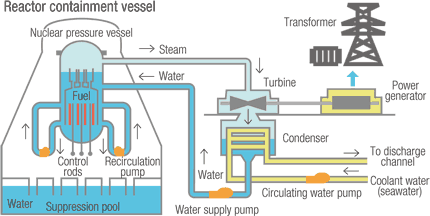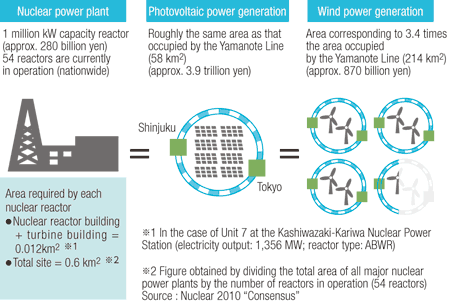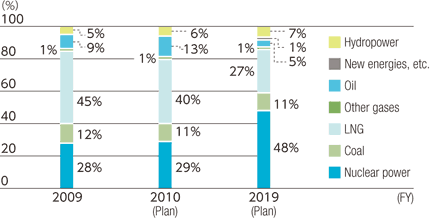Nuclear power generation forms the core of global warming countermeasures as a power generating method that releases no CO2 in the process of generating power.
While placing top priority on ensuring safety, TEPCO promotes nuclear power generation as a base load supply, to secure stable energy supply and contribute to realizing a low-carbon society.
Nuclear power generation provides outstanding environmental performance. It generates power by utilizing the heat that is released during the nuclear fission of uranium fuel inside a reactor, and like photovoltaic and wind power generation, it releases no CO2, the primary cause of global warming, nor NOx and SOx, the major sources of air pollution, in the process of generating power.
Overview of nuclear power generation

Through these initiatives we expect to reduce CO2 emissions by approximately 98.3 million tons (48%), compared to if all electricity is produced by average oil-fired thermal power generation. Among the initiatives, nuclear power generation would contribute to reducing CO2 emissions by approximately 55.2 million tons (corresponding to 56% of estimated total reduction of CO2 emissions).
Nonconformity disclosure criteria

To reduce carbon levels on the electricity supply side, we are promoting nuclear power generation, as well as the expanded utilization of sunlight, wind, and other renewable energy sources.
Photovoltaic and wind power generation systems are "zero emission power sources" that emit no CO2 in the process of generating power, just like nuclear power generation. However, in order to produce the same amount of electricity as a single nuclear reactor, they require a vast area of land and considerable construction expenses. Therefore, it can be said that nuclear power generation is a more economically efficient power source compared to photovoltaic and wind power generation.
Comparison of required area and cost between nuclear power and renewable energies (photovoltaic and wind power)

Nuclear power contributed approximately 28% to the total amount of electricity produced by TEPCO in FY2009. We plan to increase the share of nuclear power to around 48% by FY2019, through safe and stable operations of existing plants and the construction of new plants.
Changes in power output (including purchased power)

© Tokyo Electric Power Company Holdings, Inc.